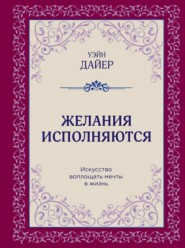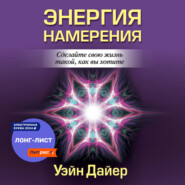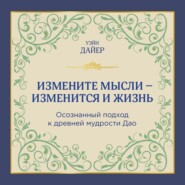По всем вопросам обращайтесь на: info@litportal.ru
(©) 2003-2025.
✖
Wisdom of The Ages: 60 Days to Enlightenment
Автор
Год написания книги
2019
Настройки чтения
Размер шрифта
Высота строк
Поля
Wayne W. Dyer
MEDITATION (#ulink_03185f31-8ee5-5dfc-9e67-771a81af172b)
Learn to be silent.
Let your
quiet mind
listen and absorb.
PYTHAGORAS
(580 B.C.–500 B.C.)
A Greek philosopher and mathematician, Pythagoras was especially interested in the study of mathematics in relation to weights and measures and to musical theory.
All man’s miseries derive from not being
able to sit quietly in a room alone.
BLAISE PASCAL
(1623-1662)
Blaise Pascal was a French philosopher, scientist, mathematician, and writer, whose treatises contributed to the fields of hydraulics and pure geometry.
This is the one time in this collection of great contributors that I have elected to highlight two writers on the same subject. I selected two men whose lives were separated by over two millennia, both of whom in their own times were considered the most knowledgeable in the rational fields of mathematics and science.
Pythagoras, whose writings influenced the thought of Plato and Aristotle, was a major contributor to the development of both mathematics and Western rational philosophy. Blaise Pascal, a famous French mathematician, physicist, and religious philosopher who lived twenty-two centuries after Pythagoras, is considered one of the original scientific minds. He is responsible for inventing the syringe, the hydraulic press, and the first digital calculator. Pascal’s Law of Pressure is still taught in science classes around the world today.
Keeping in mind the left-brained scientific leanings of these two scientists, reread their two quotes. Pascal: “All man’s miseries derive from not being able to sit quietly in a room alone.” Pythagoras: “Learn to be silent. Let your quiet mind listen and absorb.” They both speak to the importance of silence and the value of meditation in your life, whether you are an accountant or an avatar. They send us a valuable message about a way of being in life that is not popularly encouraged in our culture: that there is tremendous value in creating alone time in your life that is spent in silence. If you want to shed your miseries, learn to sit silently in a room alone and meditate.
It has been estimated that the average person has sixty thousand separate thoughts each and every day. The problem with this is that we have the same sixty thousand thoughts today that we had yesterday, and we’ll repeat them again tomorrow. Our minds are filled with the same chatter day in and day out. Learning to be quiet and meditate involves figuring out a way to enter the spaces between your thoughts; or the gap, as I call it. In this silent empty space between your thoughts, you can find a sense of total peace in a realm that is ordinarily unknowable. Here, any illusion of your separateness is shattered. However, if you have sixty thousand separate thoughts in a day, there is literally no time available to enter the space between your thoughts, because there is no space!
Most of us have minds that race full-speed day and night. Our thoughts are a hodgepodge of continuous dialogue about schedules, money worries, sexual fantasies, grocery lists, drapery problems, concern about the children, vacation plans, and on and on like a merry-go-round that never stops. Those sixty thousand thoughts are usually about ordinary daily activities and create a mental pattern that leaves no space for silence.
This pattern reinforces our cultural belief that all gaps in conversation (silence) need to be filled quickly. For many, silence represents an embarrassment and a social defect. Therefore we learn to jump in to fill these spaces, whether or not our filler has any substance. Silent periods in a car or at a dinner are perceived as awkward moments, and good conversationalists know how to get those spaces occupied with some kind of noise.
And so it is with ourselves as well; we have no training in silence, and we see it as unwieldy and confusing. Thus we keep the inner dialogue going just like the outer. Yet it is in that silent place, where our ancient teacher Pythagoras tells us to let our quiet mind listen and absorb, that confusion will disappear and enlightened guidance will come to us. But meditation also affects the quality of our nonsilent activities. The daily practice of meditation is the single thing in my life that gives me a greater sense of well-being, increased energy, higher productivity at a more conscious level, more satisfying relationships, and a closer connection to God.
The mind is like a pond. On the surface you see all the disturbances, yet the surface is only a fraction of the pond. It is in the depth below the surface, where there is stillness, that you will come to know the true essence of the pond, as well as your own mind. By going below the surface, you come to the spaces between your thoughts where you are able to enter the gap. The gap is total emptiness or silence, and it is indivisible. No matter how many times you cut silence in half, you still get silence. This is what is meant by now. Perhaps it is the essence of God, that which cannot be divided from the oneness.
These two pioneering scientists, who are still quoted today in university courses, were studying the nature of the universe. They struggled with the mysteries of energy, pressure, mathematics, space, time, and universal truths. Their message to all of us here is quite simple. If you want to understand the universe, or your own personal universe, if you want to know how it all works, then be quiet and face your fear of sitting in a room alone and going deep within the layers of your own mind.
It is the space between the notes that makes the music. Without that emptiness, that silence in between, there is no music, only a noise. You too are silent empty space at your center, surrounded by form. To break through that form and discover your very creative nature that is in the center, you must take the time to become silent each day, and enter that rapturous space between your thoughts. No amount of my writing about the value of daily meditation will ever convince you. You will never know the value of this practice unless you make the commitment to do it.
My purpose in writing this brief essay on the value of meditation is not to tell you how to meditate. There are many fine courses of study, manuals, and audio guides to give you instruction. My purpose here is to emphasize that meditation is not something that is exclusively for spiritual seekers who want to wile away the hours and days of their lives in deep contemplation, oblivious to productivity and social responsibility. Meditation is a practice advocated by those who live by their faith in reason, by number crunchers and authors of theorems and believers in Pascal’s Law. You may feel much as Blaise Pascal did when he wrote, “The eternal silence of these infinite spaces terrifies me.”
Here are some suggestions for overcoming your terror and learning to be silent and able to sit quietly in a room alone:
Practice noticing your in and out breaths as a way to cultivate turning inward to the silent self. You can do this in the middle of meetings, conversations, even parties. Just notice and follow your breathing for a few moments, many times during your day.
Give yourself time this day to simply sit in a room alone and observe your mind. Keep track of the various thoughts that enter, exit, and lead to the next thought. Your awareness of the frenetic activity of your mind will help you to transcend the frenzied pace of thoughts.
Read a book on meditation to learn how the practice can be initiated, or join a meditation group. Many teachers and local organizations can get you started on this path. The Chopra Center for Well-Being in La Jolla, California, headed by my friend and colleague Deepak Chopra, teaches meditation as a part of its large offering of services.
Many CDs and tapes are available to guide you in meditation. Find one that appeals to you. I have published one entitled Meditation for Manifesting in which I teach a specific meditation called JAPA. I guide you through a morning and evening meditation using my voice to assist you in repeating the sounds of the divine. The profits go to charity.
KNOWING (#ulink_bfecfeab-8d28-5e4b-8676-ccab46f0f8ad)
Do not believe what you have heard.
Do not believe in tradition because it is handed down many generations.
Do not believe in anything that has been spoken of many times.
Do not believe because the written statements come from some old sage.
Do not believe in conjecture.
Do not believe in authority or teachers or elders.
But after careful observation and analysis, when it agrees with reason and it will benefit one and all, then accept it and live by it.
BUDDHA
(563 B.C.–483 B.C.)
Founder of Buddhism, one of the world’s major religions, the Buddha was born Prince Siddhartha Gautama in northeast India, near the borders of Nepal. Seeing the unhappiness, sickness, and death that even the wealthiest and most powerful are subject to in this life, at age twentynine he abandoned the life he was living in search of a higher truth.
The name Buddha is actually a title that translates to the “awakened one” or the “enlightened one.” It is the title given to Siddhartha Gautama, who left behind the princely life at the age of twenty-nine and went on a lifelong search for religious understanding and a way of release from the human condition. It is said that he discarded the teachings of his contemporaries and through meditation achieved enlightenment or ultimate understanding. From then on he assumed the role of teacher, instructing his followers in the “dharma,” or truth.
His teachings became the basis for the religious practice of Buddhism, which has played a major role in the spiritual, cultural, and social life of the Eastern world, and much of the Western world as well. I have deliberately chosen not to write, in this essay, on the tenets of Buddhist doctrine, but rather to take this often-quoted passage of the Buddha and discuss its significance to you and me today, some twenty-five centuries after the death of the enlightened one.
The key word in the passage is “believe.” In fact, the key phrase is “Do not believe:” Everything you carry around with you that you call a belief has become your own largely because of the experiences and testimonies of other people. And if it comes to you from a source outside yourself, regardless of how persuasive the conditioning process might be, and of how many people just like you have worked to convince you of the truth of these beliefs, the fact that it is someone else’s truth means that you receive it with some question marks or doubts.
If I were to attempt to convince you about the taste of a delectable fish, you would perhaps listen but still have your doubts. Were I to show you pictures of this fish, and have hundreds of people come to testify about the veracity of my statements, you might become more convinced. But the modicum of doubt would still remain because you hadn’t tasted it. You might accept the truth of its deliciousness for me; but until your taste buds experience the fish, your truth is only a belief based on my truth, on my experience. And so it is also with all the well-meaning members of your tribes, and their tribal ancestors before them.
Just because you have heard it, and it is a long-surviving tradition, and it is recorded over the centuries, and the world’s greatest teachers have endorsed it, those are still not reasons to accept a belief. Remember, “Do not believe it,” as Buddha instructs.
Rather than using the term “belief,” try shifting to the word “knowing.” When you have the direct experience of tasting the fish, you now have a knowing. That is, you have conscious contact and can determine your truth based on your experience. You know how to swim or ride a bicycle not because you have a belief, but because you have had the direct experience.
You are being reminded, directly by the “enlightened one” of twenty-five hundred years ago, to apply this same understanding to your spiritual practice. There is a fundamental difference between knowing something and knowing about something. “Knowing about” is another term for belief. “Knowing” is a term reserved exclusively for direct experience, which means an absence of doubt. I recall a well-known Kahuna healer responding to my questions about how a Kahuna becomes a healer. He said to me, “When a knowing confronts a belief in a disease process, the knowing will always triumph. Kahunas,” he explained to me, “were raised to abandon all doubt and to know.”
When I think of the parables of Jesus Christ as a great healer, I can’t conjure any doubt. When Christ approached a leper he wouldn’t say, “We haven’t been having a great deal of success with leprosy lately. But if you follow my advice you’ll have a thirty percent chance of survival over the next five years.” You can see all the doubt that is present in such a stance. Rather, he would say from an absolute state of knowing, “You are healed.” This is the same state of conscious contact with knowing from which St. Francis performed his healing miracles as well. In fact, all miracles come from shifting out of doubt and into knowing.
Yet the persuasiveness of tribal influences is exceedingly powerful. You are constantly being reminded of what you should or shouldn’t believe, and what all our tribal members have always believed, and what will happen to you if you ignore these beliefs. Fear becomes the constant companion of your beliefs, and despite the doubts that you may be feeling inside, you often adopt these beliefs and make them crutches in your life, while you hobble through your days looking for a way out of the traps that have been carefully set by generations of believers before you.















